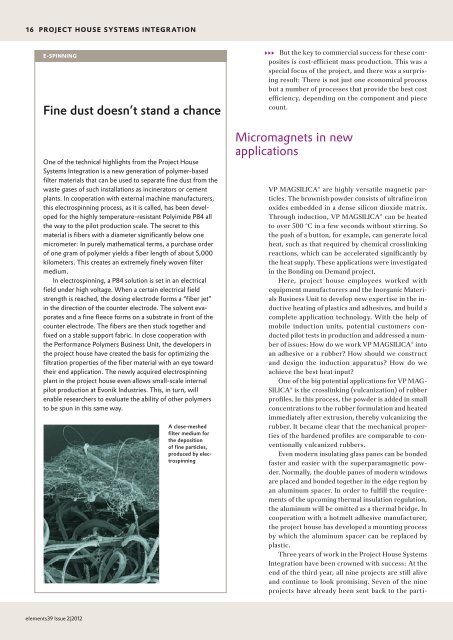Download - Evonik Industries
Download - Evonik Industries
Download - Evonik Industries
You also want an ePaper? Increase the reach of your titles
YUMPU automatically turns print PDFs into web optimized ePapers that Google loves.
16 PRoJeCt HoUse sYsteMs InteGRAtIon<br />
e-sPInnInG<br />
Fine dust doesn’t stand a chance<br />
One of the technical highlights from the Project House<br />
Systems Integration is a new generation of polymer-based<br />
filter materials that can be used to separate fine dust from the<br />
waste gases of such installations as incinerators or cement<br />
plants. In cooperation with external machine manufacturers,<br />
this electrospinning process, as it is called, has been developed<br />
for the highly temperature-resistant Polyimide P84 all<br />
the way to the pilot production scale. The secret to this<br />
material is fibers with a diameter significantly below one<br />
micrometer: In purely mathematical terms, a purchase order<br />
of one gram of polymer yields a fiber length of about 5,000<br />
kilometers. This creates an extremely finely woven filter<br />
medium.<br />
In electrospinning, a P84 solution is set in an electrical<br />
field under high voltage. When a certain electrical field<br />
strength is reached, the dosing electrode forms a “fiber jet”<br />
in the direction of the counter electrode. The solvent evaporates<br />
and a fine fleece forms on a substrate in front of the<br />
counter electrode. The fibers are then stuck together and<br />
fixed on a stable support fabric. In close cooperation with<br />
the Performance Polymers Business Unit, the developers in<br />
the project house have created the basis for optimizing the<br />
filtration properties of the fiber material with an eye toward<br />
their end application. The newly acquired electrospinning<br />
plant in the project house even allows small-scale internal<br />
pilot production at <strong>Evonik</strong> <strong>Industries</strong>. This, in turn, will<br />
enable researchers to evaluate the ability of other polymers<br />
to be spun in this same way.<br />
elements39 Issue 2|2012<br />
A close-meshed<br />
filter medium for<br />
the deposition<br />
of fine particles,<br />
produced by electrospinning<br />
333 But the key to commercial success for these composites<br />
is cost-efficient mass production. This was a<br />
special focus of the project, and there was a surprising<br />
result: There is not just one economical process<br />
but a number of processes that provide the best cost<br />
efficiency, depending on the component and piece<br />
count.<br />
Micromagnets in new<br />
applications<br />
VP MAGSILICA® are highly versatile magnetic particles.<br />
The brownish powder consists of ultrafine iron<br />
oxides embedded in a dense silicon dioxide matrix.<br />
Through induction, VP MAGSILICA® can be heated<br />
to over 500 °C in a few seconds without stirring. So<br />
the push of a button, for example, can generate local<br />
heat, such as that required by chemical crosslinking<br />
reactions, which can be accelerated significantly by<br />
the heat supply. These applications were investigated<br />
in the Bonding on Demand project.<br />
Here, project house employees worked with<br />
equipment manufacturers and the Inorganic Materials<br />
Business Unit to develop new expertise in the inductive<br />
heating of plastics and adhesives, and build a<br />
complete application technology. With the help of<br />
mobile induction units, potential customers conducted<br />
pilot tests in production and addressed a number<br />
of issues: How do we work VP MAGSILICA® into<br />
an adhesive or a rubber? How should we construct<br />
and design the induction apparatus? How do we<br />
achieve the best heat input?<br />
One of the big potential applications for VP MAG-<br />
SILICA® is the crosslinking (vulcanization) of rubber<br />
profiles. In this process, the powder is added in small<br />
concentrations to the rubber formulation and heated<br />
immediately after extrusion, thereby vulcanizing the<br />
rubber. It became clear that the mechanical properties<br />
of the hardened profiles are comparable to conventionally<br />
vulcanized rubbers.<br />
Even modern insulating glass panes can be bonded<br />
faster and easier with the superparamagnetic powder.<br />
Normally, the double panes of modern windows<br />
are placed and bonded together in the edge region by<br />
an aluminum spacer. In order to fulfill the requirements<br />
of the upcoming thermal insulation regulation,<br />
the aluminum will be omitted as a thermal bridge. In<br />
cooperation with a hotmelt adhesive manufacturer,<br />
the project house has developed a mounting process<br />
by which the aluminum spacer can be replaced by<br />
plastic.<br />
Three years of work in the Project House Systems<br />
Integration have been crowned with success: At the<br />
end of the third year, all nine projects are still alive<br />
and continue to look promising. Seven of the nine<br />
projects have already been sent back to the par ti -
















